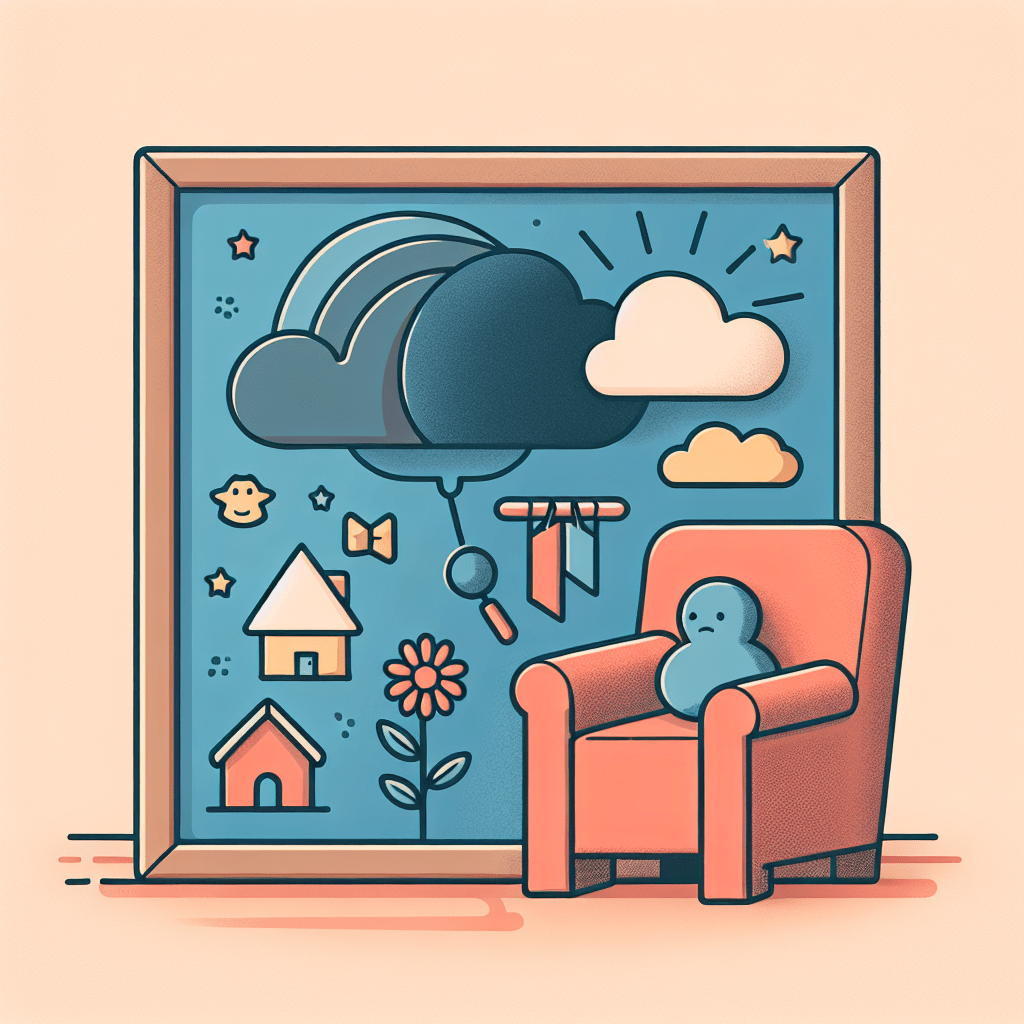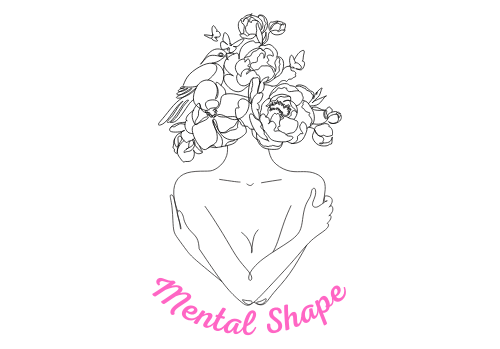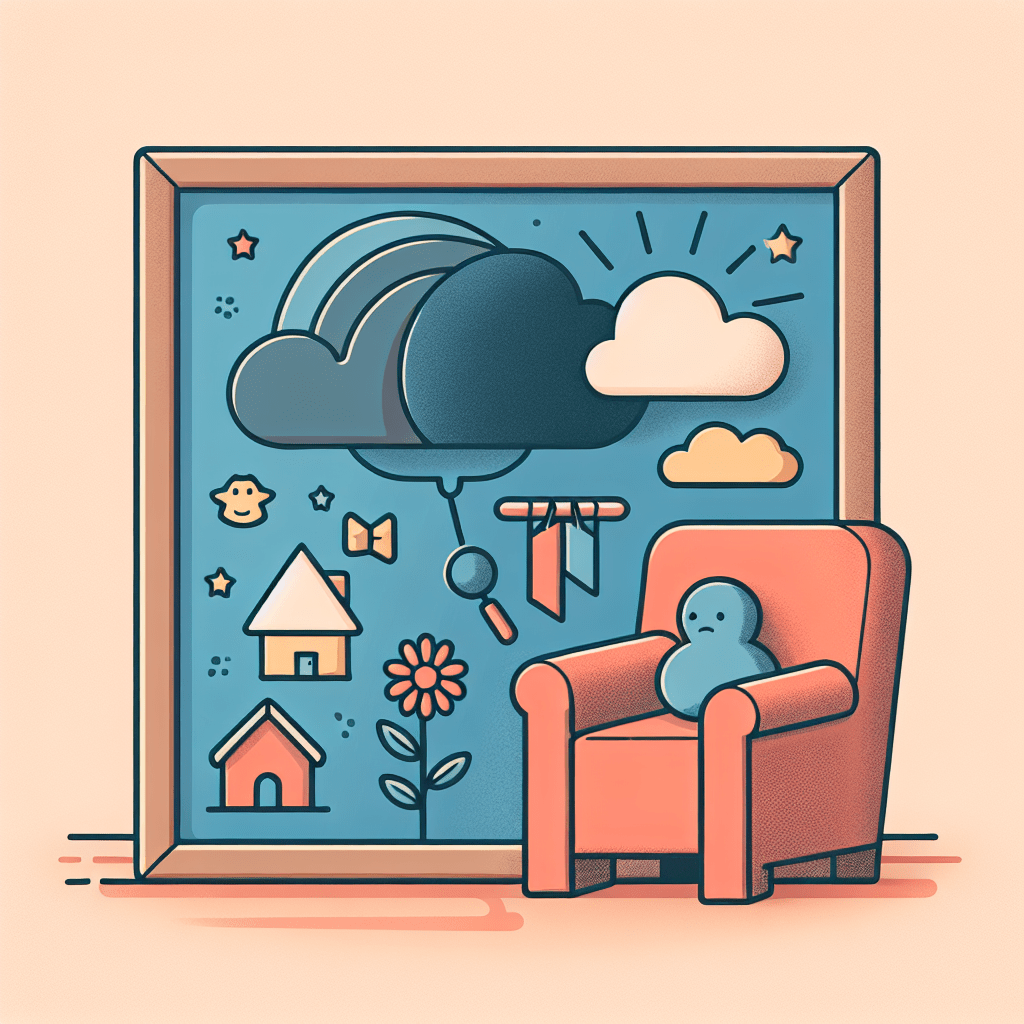Are you worried about your child’s anxiety? You’ll be relieved to know that there are a variety of therapy services available to help your little one overcome their challenges. From cognitive-behavioral therapy to play therapy, these treatments are tailored specifically for children and aim to alleviate symptoms of anxiety while promoting healthy coping mechanisms. If you’re curious about the different therapy options available for children with anxiety, read on to discover the potential avenues for your child’s healing and growth.

Cognitive Behavioral Therapy (CBT)
Understanding CBT
Cognitive Behavioral Therapy, or CBT, is a widely-used therapeutic approach in treating children with anxiety. It focuses on helping children recognize and challenge negative thoughts and beliefs that contribute to their anxiety. CBT aims to teach children effective coping strategies and behavioral techniques to manage their anxiety symptoms. The therapy is based on the premise that our thoughts, emotions, and behaviors are interconnected, and by changing our thoughts and behaviors, we can effectively reduce anxiety.
Key components of CBT for children with anxiety
CBT for children with anxiety typically involves several key components. These include psychoeducation, where the therapist educates the child and their parents about anxiety and the cognitive model of CBT. The therapist then helps the child identify and challenge their negative thoughts and beliefs, using techniques such as cognitive restructuring. Additionally, relaxation and breathing exercises are often taught to help children manage physical symptoms of anxiety. Exposure therapy, which involves gradually exposing the child to anxiety-provoking situations, may also be incorporated into CBT.
Benefits of CBT for children with anxiety
CBT has been shown to be highly effective in treating anxiety in children. It equips children with skills and strategies to effectively manage their anxiety symptoms, both in the short-term and long-term. CBT helps children develop a greater understanding of their anxiety, which empowers them to take control of their thoughts and behaviors. Research has shown that CBT reduces anxiety symptoms and improves overall functioning in children with anxiety disorders. Furthermore, the skills learned in CBT can be applied to various situations throughout a child’s life, aiding in the prevention of future anxiety episodes. Overall, CBT provides children with the tools they need to overcome their anxiety and lead happier, more fulfilling lives.
Play Therapy
Overview of play therapy
Play therapy is a form of therapy that utilizes play to help children express and process their emotions. It is particularly effective in treating children with anxiety, as it provides a safe and controlled environment for them to explore their fears and worries. Play therapy allows children to communicate using their natural language of play, enabling them to better understand and manage their anxiety.
Benefits of play therapy for children with anxiety
Play therapy offers numerous benefits for children with anxiety. Firstly, it allows children to freely express their emotions and worries, without the pressure of verbal expression. Through play, children can act out and process their anxieties and fears, leading to a greater sense of understanding and control. Play therapy also helps children develop coping skills, as they can explore different strategies for managing their anxiety within the context of play. Additionally, play therapy strengthens the therapeutic bond between the child and therapist, establishing a safe and trusting relationship that facilitates healing and growth.
Different techniques used in play therapy
Various techniques are employed in play therapy to support children in managing their anxiety. Sandplay, for example, involves the child creating scenes in a tray of sand using miniature figures, allowing them to express their inner world symbolically. Art therapy is another technique used, where children use different art materials to depict their feelings and experiences related to anxiety. Play therapists may also incorporate role-playing, storytelling, and puppetry, among other techniques, to help children explore and understand their anxiety in a playful and supportive manner.
Exposure Therapy
Overview of exposure therapy
Exposure therapy is a form of therapy that gradually exposes individuals to feared or anxiety-inducing situations to reduce their anxiety response. This therapeutic approach is particularly effective in treating anxiety disorders in children, as it helps them confront their fears in a safe and controlled manner. Exposure therapy is based on the principle of desensitization, whereby repeated exposure to anxiety-provoking stimuli gradually reduces the fear response.
How exposure therapy is used to treat anxiety in children
In the context of anxiety treatment for children, exposure therapy involves systematically exposing the child to anxiety-provoking situations or stimuli. This exposure is done in a gradual and controlled manner, starting with situations that evoke mild anxiety and progressively increasing the level of difficulty. For example, a child with a fear of dogs may initially be exposed to pictures of dogs, then gradually move on to watching videos of dogs, and ultimately progress to interacting with dogs in real life. Throughout the exposure process, the child learns to manage their anxiety through various coping strategies, such as deep breathing or positive self-talk.
Benefits and limitations of exposure therapy for children with anxiety
Exposure therapy has shown great success in treating anxiety in children. By confronting their fears head-on, children gradually learn that their anxiety does not have to control them. Exposure therapy helps children build resilience and self-confidence, as they face and overcome their fears. It also provides them with a sense of mastery and control over their anxiety symptoms. However, it is important to note that exposure therapy may not be suitable for all children, especially those with severe anxiety or trauma-related issues. It is crucial that exposure therapy is conducted under the guidance of a trained therapist to ensure it is implemented safely and effectively.
Family Therapy
Definition and purpose of family therapy
Family therapy involves the participation of family members in the treatment process to address the impact of anxiety on the entire family unit. It recognizes that a child’s anxiety does not exist in isolation, but rather affects and is influenced by family dynamics and relationships. The purpose of family therapy is to improve family functioning, strengthen communication and support within the family, and promote the overall well-being of both the child and the family as a whole.
Involvement of family members in the treatment process
In family therapy, various family members, including parents and siblings, actively participate in the treatment process. The therapist creates a safe and non-judgmental space for family members to express their thoughts, feelings, and concerns related to the child’s anxiety. Through open and honest communication, the therapist helps family members better understand and empathize with each other’s experiences, fostering a sense of unity and collaboration. Family members are also involved in implementing strategies and interventions recommended by the therapist to support the child’s progress and manage anxiety symptoms effectively.
Benefits and challenges of family therapy for children with anxiety
Family therapy offers several benefits for children with anxiety. By involving the entire family, it promotes a supportive and understanding environment that can reduce the child’s anxiety. Family members gain insight into how their interactions and behaviors may influence the child’s anxiety, allowing for positive changes within the family system. Family therapy also provides an opportunity for parents to learn effective parenting strategies for managing their child’s anxiety and promoting their resilience. However, it is important to acknowledge that family therapy may also present challenges, such as navigating sensitive family dynamics and ensuring equal participation and engagement from all family members. These challenges can be addressed through open communication and collaboration between the therapist and the family.
Art Therapy
Understanding art therapy
Art therapy is a creative and expressive form of therapy that utilizes various art materials and techniques to help children with anxiety. It provides a means for children to communicate and explore their thoughts, emotions, and experiences in a non-verbal and non-threatening way. Art therapy allows children to externalize their anxiety and gain insight into their internal world, ultimately promoting healing and self-discovery.
Benefits of art therapy for children with anxiety
Art therapy offers numerous benefits for children with anxiety. Firstly, it provides a safe and supportive outlet for children to express their anxiety and related emotions. Through art-making, children can visually represent their fears, worries, and coping strategies, fostering a greater understanding of their anxiety. Art therapy also enhances self-esteem and self-expression, as children see their creations as a reflection of their inner thoughts and feelings. Additionally, art therapy encourages creativity and imagination, which can be empowering for children in managing their anxiety.
Various art techniques and activities used in therapy sessions
Art therapy sessions incorporate a wide range of art techniques and activities to engage children in the therapeutic process. Drawing, painting, sculpting, and collage-making are commonly used techniques that allow children to explore different mediums and textures. Guided imagery exercises, where children create visual representations of their anxiety or calm place, can help them gain a sense of control over their emotions. Therapists may also use storytelling, mask-making, or body mapping as art-based activities to further facilitate self-expression and emotional exploration.
Dialectical Behavior Therapy (DBT)
Overview of DBT
Dialectical Behavior Therapy, or DBT, is a therapeutic approach that combines elements of cognitive-behavioral therapy with mindfulness and acceptance-based strategies. It was initially developed to treat individuals with borderline personality disorder but has been adapted for children with anxiety. DBT aims to help children develop emotional regulation skills, improve interpersonal relationships, and promote self-acceptance.
Key components of DBT for children with anxiety
DBT for children with anxiety typically involves four key components: mindfulness, distress tolerance, emotion regulation, and interpersonal effectiveness. Mindfulness practices teach children to be present in the moment, allowing them to observe their thoughts and emotions without judgment. Distress tolerance skills equip children with strategies to cope with distressing situations or emotions without resorting to maladaptive behaviors. Emotion regulation skills focus on helping children identify, understand, and manage their emotions effectively. Interpersonal effectiveness skills teach children effective communication and relationship-building strategies.
Effectiveness of DBT for children with anxiety
Research has shown that DBT can be highly effective in reducing anxiety symptoms in children. By combining cognitive-behavioral techniques with mindfulness and acceptance-based strategies, DBT provides children with a comprehensive toolkit to manage their anxiety. DBT helps children develop greater emotional awareness and regulation, allowing them to respond to anxiety-provoking situations in a more adaptive manner. Additionally, the emphasis on mindfulness in DBT helps children cultivate a nonjudgmental and accepting attitude towards their anxiety, reducing the impact and intensity of anxiety symptoms. Overall, DBT offers a holistic and evidence-based approach to treating anxiety in children.
Mindfulness and Meditation
Explanation of mindfulness and meditation
Mindfulness is the practice of intentionally bringing one’s attention to the present moment without judgment. It involves cultivating a state of awareness and acceptance of one’s thoughts, emotions, and bodily sensations. Meditation, on the other hand, is a formal practice that involves intentionally focusing one’s attention on a specific object or sensation, such as the breath or a sound, to cultivate mindfulness.
Benefits of mindfulness and meditation for children with anxiety
Mindfulness and meditation have been shown to have numerous benefits for children with anxiety. Regular practice can help children develop greater self-awareness, allowing them to recognize and manage their anxiety symptoms more effectively. Mindfulness cultivates a nonjudgmental attitude, reducing self-criticism and increasing self-compassion, which can be particularly helpful for children with anxiety. Meditation also promotes relaxation and stress reduction, helping children regulate their emotions and achieve a greater sense of calm.
Practical techniques for practicing mindfulness and meditation
There are various practical techniques that children can use to practice mindfulness and meditation. Simple breathing exercises, such as focusing on the sensation of the breath or counting breaths, can help children anchor their attention and cultivate mindfulness. Guided meditations, either in person or through audio recordings, provide children with structured instructions to aid their meditation practice. Mindful movement practices, such as yoga or walking meditation, combine physical movement with mindfulness, allowing children to engage their bodies and minds simultaneously. It is important for children to establish a consistent mindfulness and meditation routine for optimal benefits.
Animal-Assisted Therapy
Understanding animal-assisted therapy
Animal-assisted therapy involves the use of animals, typically trained therapy animals, as part of the therapeutic process. Animals, such as dogs or horses, are incorporated into therapy sessions to provide comfort, companionship, and support to children with anxiety. This type of therapy recognizes the positive impact that animals can have on mental health and emotional well-being.
Benefits of animal-assisted therapy for children with anxiety
Animal-assisted therapy offers several benefits for children with anxiety. Interacting with animals has been shown to reduce anxiety and promote feelings of calm and relaxation. Animals provide unconditional love and support, creating a safe and non-judgmental space for children to express and process their anxiety. The presence of an animal can also facilitate trust and communication between the child and therapist, aiding in the therapeutic process. Animal-assisted therapy has been found to improve social skills, increase self-esteem, and enhance overall emotional well-being in children with anxiety.
Different animals commonly used in therapy sessions
Various animals are commonly used in animal-assisted therapy for children with anxiety. Dogs are often the most popular choice, as they are known for their loyal and comforting nature. Equine-assisted therapy, which involves interactions with horses, has also gained popularity in recent years due to the calming and grounding presence of these animals. Other animals, such as cats, rabbits, or guinea pigs, may also be used depending on the therapeutic goals and preferences of the child. The choice of animal is based on their temperament, training, and ability to meet the specific needs of the child.
Group Therapy
Benefits of group therapy for children with anxiety
Group therapy offers numerous benefits for children with anxiety. Being part of a group allows children to realize that they are not alone in their struggles and that others share similar experiences. Group therapy provides a sense of belonging and community, which can alleviate feelings of isolation and create a supportive environment for growth and healing. It also offers opportunities for social interaction and skill-building, as children learn from each other and practice new coping strategies in a safe and structured setting.
Types of group therapy programs available
There are various types of group therapy programs available for children with anxiety. Skills-based groups focus on teaching children specific techniques and strategies to manage their anxiety, such as relaxation exercises or cognitive restructuring. Support groups provide an opportunity for children to share their experiences, express their emotions, and receive support and validation from their peers. Peer-led groups, facilitated by trained individuals who have experience with anxiety, foster a sense of empowerment and solidarity among group members. It is important to choose a group therapy program that is tailored to the unique needs and preferences of the child.
Structure and activities in a group therapy session
Group therapy sessions typically follow a structured format, with a combination of group discussions, activities, and exercises. Group members are encouraged to share their thoughts, feelings, and experiences related to anxiety, fostering open and honest communication. Therapists may incorporate role-playing, problem-solving exercises, or art-based activities to facilitate learning and emotional expression. Group members are often assigned homework or practice exercises to reinforce skills learned in therapy sessions and promote continued growth outside of the group setting.
Medication Management
Role of medication in anxiety treatment for children
Medication can play a role in the treatment of anxiety in children, especially when symptoms are severe or significantly impacting the child’s daily functioning. Medications commonly prescribed for childhood anxiety include selective serotonin reuptake inhibitors (SSRIs), such as fluoxetine or sertraline. These medications help regulate serotonin levels in the brain, which can improve mood and reduce anxiety symptoms. It is important to note that medication should always be used in conjunction with therapy, as it does not address the underlying causes of anxiety and is typically intended to be a short-term solution.
Commonly prescribed medications for childhood anxiety
SSRIs are the most commonly prescribed medications for childhood anxiety. These medications have been extensively studied and shown to be effective in reducing anxiety symptoms in children. Other medications that may be prescribed in certain cases include selective norepinephrine reuptake inhibitors (SNRIs) or benzodiazepines. The choice of medication depends on the child’s specific symptoms, medical history, and the professional judgment of the prescribing doctor. It is crucial that medication management is closely monitored by a qualified healthcare professional to ensure safety and effectiveness.
Considerations and limitations of medication management
While medication can be beneficial in reducing anxiety symptoms, it is important to consider the potential limitations and side effects. Every child is unique, and responses to medication can vary. It may take time to find the right medication and dosage that works best for each individual child. Additionally, medication management should always be accompanied by ongoing therapy to address the underlying causes of anxiety and develop long-term coping skills. Regular monitoring and communication with the prescribing doctor is essential to assess the effectiveness and adjust the medication as needed. It is important for parents to have open and honest discussions with healthcare providers to fully understand the benefits and potential risks of medication management.

